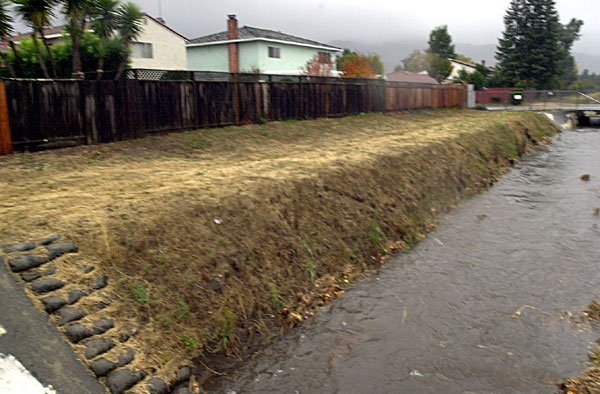GILROY
– The Santa Clara Valley Water District wants to expand its
authority over land-use along area waterways, but its proposal to
take control of review and permitting for development within a
150-foot swath of creekbeds is being met with skepticism by area
farmers and city officials.
GILROY – The Santa Clara Valley Water District wants to expand its authority over land-use along area waterways, but its proposal to take control of review and permitting for development within a 150-foot swath of creekbeds is being met with skepticism by area farmers and city officials.
Water district officials said they decided to rewrite the old law two years ago to better reflect the district’s expanded mission of stream stewardship and enmesh and balance it with more traditional district responsibilities of flood control and water quality.
“The (current) ordinance is almost 20 years old,” said Beau Goldie, a district official helping manage the revision project. “In this past 20 years, a lot has changed, both in the regulatory requirements placed on the district, the interests of the community and just the way business is done.”
“We want to make sure someone isn’t building a structure within an area that would cause or contribute to erosion or get in the way of flows within the creeks themselves,” Goldie said. “We need to review that.”
Several cities have argued the water district is moving in on their land-use authority.
“The district can’t unilaterally impose its authority beyond its right of way without easement or agreement,” wrote Richard Mauck, a public works official with the city of Santa Clara.
Other stakeholders say the ordinance doesn’t spell out how they’ll be affected enough for them to render much of a judgement at all.
For example, Goldie admitted the ordinance is “silent” on how it would affect agricultural operations. The Santa Clara County Farm Bureau has asked the district to come to South County for a meeting to explain the provisions and concerns.
“The real question is that it doesn’t spell out what you can or cannot do …” within the new proposed creekside boundaries, said Jenny Midtgaard Derry, the farm bureau’s executive director.
Currently, the district has permitting authority within 50 feet of the top of the bank under what is known as Ordinance 83-2 in bureaucratic jargon. The new ordinance could expand that distance to 150 feet or, potentially, the edge of adjacent property lines and be called the Water Resources Protection Ordinance.
Members of the South County Joint Planning Advisory Committee, a group of Morgan Hill, Gilroy and county officials that share information on regional land-use issues, has asked to review and consider the changes before they’re adopted.
That skepticism is balanced by the support of at least one conservation group supporting the effort by the Santa Clara Valley Water District, noting it could help preserve some of the Silicon Valley’s richest remaining wildlife habitat from the effects of major development.
Craig Breon, director of the county’s Audubon Society, said the move to revamp the laws is a step in the right direction that not only will help protect fish, birds and wildlife, but also make flood-control projects better and cheaper and help safeguard the water supply.
“Bad land-use decisions can affect the district in all its missions, and this allows them to address at least some of those decisions out there,” he said.
A healthy creekside area can boast more than 140 species of birds on a spring day, he noted.
“People really like these streamside areas,” he said. “They’re the last bit of wildness running through our cities.”
The SCVWD, however, has decided to delay an impending vote on the new law after noting the concern from city and agriculture leaders.
Other provisions in the revised ordinance could include more stringent rules on increases in pollutant-carrying peak runoff flows from streamside projects, higher permitting standards for devices that capture and release stormwater and regulations on how vegetation is removed or planted that are meant to avoid erosion and the introduction of certain invasive species.
Although specifics are still being worked out, the changes are aimed at mostly new and larger residential, commercial and industrial projects that alter, say, 5,000 square feet of land or more, Goldie said – not necessarily existing, non-polluting commerical operations or minor backyard activity by private homeowners.
“It’s those larger projects that are the ones that will really have the impacts,” he said.
The water district board, which oversees the management of the county’s water resources, originally was slated to adopt a revised ordinance next month. But officials decided this week to put off that vote and begin a new collaborative process to discuss and revise the ordinance, similar to one that was used for a flood control project along the Guadalupe River corridor.
The process likely would involve a series of meetings over several months and include representatives from the county, several cities, conservationists, homebuilders and the regional water quality board.
Officials plan to send a letter to the county’s mayors inviting their cities to participate.















